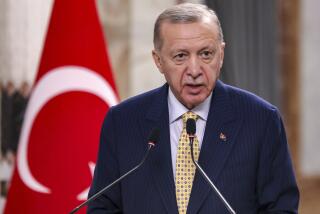ASIAN ECONOMIC UNITY? : Pacific Rim: The nations consider a trade bloc to counter what they fear is increasing protectionism in the West.
- Share via
A growing number of Asian nations are considering forming an Asia Pacific trade bloc to counter what they fear is increasing protectionism from trade zones being created or proposed by the European Community and the governments of North America.
The scheme--by promoting trade between many Asian nations that until now have not been close trading partners--is in some ways more ambitious than the plan that will create a single economic European Community in 1992, analysts say. That’s because many European Community members already have extensive trade ties and are at generally similar stages of economic development.
The concept could also produce a union that is as formidable as the free-trade zone that President Bush envisions for the United States, Mexico and Canada, observers say.
But an Asian trade bloc--if it encourages protectionism and ignites trade wars--could have enormous detrimental consequences for the United States by making it harder for Americans to gain access to lucrative and burgeoning Asian markets, analysts say. And it could stifle international trade by separating much of the world’s commerce into three major blocs--Europe, North America and East Asia.
Although the leading proponent of the Asian bloc is Malaysian Prime Minister Mahathir Mohammed, the biggest beneficiary could be Japan--which is why some are calling the concept a “yen bloc.” By combining the world’s most robust economy with its fastest-growing economies in one trade group, a yen bloc could pose a formidable threat to the West for global industrial and economic dominance.
Mahathir has yet to define precisely the kind of economic alliance he would like to forge. Malaysian government officials are expected to advance some proposed objectives with other Asian governments during a conference this week in Bali, Indonesia, and in the weeks ahead.
However, the general concept, developed by Malaysia two months ago, calls for Malaysia, Indonesia, Singapore, Thailand, the Philippines and Brunei--already part of a political and economic coalition known as the Assn. of Southeast Asian Nations (ASEAN)--to join with Japan, China, South Korea, Taiwan, Hong Kong, Vietnam, Cambodia and Laos.
In general, the plan is likely to call for a reduction or removal of tariffs on intra-Asian trade, according to Malaysian officials and other observers. The proposal might also call for the establishment of rules or arbitration methods designed to settle intra-Asian trade disputes and engender cooperation on matters such as incentives for foreign investment, they say.
The Malaysian effort may fail. After all, it will be difficult to forge an alliance involving advanced Japan and developing Indonesia, rich Taiwan and the poor Philippines and a political mix of communism, authoritarianism and democracy.
The effort may also be scaled down. Many observers say the most feasible arrangement is probably not a European Community-style unified market, or even tariff-free zones as proposed in North America, but a loose cooperative economic grouping that would promote intra-Asian trade but not discriminate against outsiders.
As such, the proposal may win support from the United States, which wants freer access to Asian markets, and Japan and China, which want continued export growth to U.S. and European markets. Japan and China, the largest potential members of an Asian trade bloc, fear that a restrictive grouping would invite retaliation from the United States and European Community.
But even if the Malaysians gain acceptance for a grouping that is not protectionist, such a coalition could still turn detrimental to the United States. For example, if the world’s nations are unable to develop rules for a new General Agreement on Trade and Tariffs (GATT)--a legal guideline that defines economic fair play among nations--an economic free-for-all could ensue, leaving nations free to unilaterally make their own trade rules or adhere to the guidelines of trading blocs.
Mahathir said Sunday that all six ASEAN members backed the trade bloc concept in principle. That gives Malaysia the green light to attempt to build a consensus for a detailed plan.
After initially hinting that an East Asian group might be restrictive to outsiders, Malaysia now appears to be favoring the non-protectionist approach. The Malaysians have also indicated that the objectives and operating rules of such an Asian group would be consistent with provisions of a new GATT agreement.
As such, the United States now has no objection to an Asian economic group if it merely promotes trade consistent with the free-trade principles of a GATT agreement, said Nancy Adams, assistant deputy to U.S. Trade Representative Carla Anderson Hills.
“Who are we--with two free-trade relationships of our own (with Canada and Israel) and one (with Mexico) on the way--to say they can’t do that in Asia?” Adams said.
Abdul Jabar, a spokesman for the Malaysia Embassy in Washington, said an East Asian group could address economic disputes relating to tariffs and end bidding wars between Asian nations, which sometimes compete against each other by offering bigger and bigger incentives to lure foreign investment, he said.
In addition, Malaysia and other small Asian nations may want to join together to generate leverage for trade negotiations with the West. For example, Malaysia, which has experienced rapid economic growth in recent years, is concerned that some of its exports to America may lose their duty-free status, Jabar said. The United States offers that status to some developing countries, but the Reagan Administration in 1988 took duty-free privileges away from Asia’s Four Tigers--South Korea, Taiwan, Hong Kong and Singapore--because those nations were building up large trade surpluses with the United States.
“People think we may be the next tiger, and we may lose those benefits,” Jabar said.
Although the interests of Malaysia and other small Asian nations are not always in harmony with those of Japan, Malaysian officials say they want to form a union involving Japan because the Japanese can give them the clout they need in unilateral and multilateral talks with the West.
“Malaysia is a small country, and our voice may not be heard,” Jabar said. “ASEAN is not big enough to carry clout. But if China, Korea and Japan are with us, perhaps people would pay attention. Everything would be centralized around Japan because it is economically active throughout the (Pacific Rim) region.”
Currently, the Japanese government has no official position on the Malaysian proposal but would not look favorably on any proposal calling for an exclusionary trade bloc that would limit entry of outside nations into Pacific Rim markets, said Hiroshi Hirabayashi, the economic minister at the Japanese Embassy in Washington.
Hirabayashi said the proposal is designed to prompt Japan to take a leadership role in international forums such as GATT on trade and investment issues of Asian countries.
“In the views of many Asian countries . . . the U.S. is paying enormous attention to the countries of Latin America and the Caribbean,” Hirabayashi said. “Europe is paying attention to East Europe, Africa and so on. Japan is standing on the very firm principle of globalism on matters of trade and investment. Who is taking care of Asian countries?”
But there’s another reason why the Japanese like the idea of a bloc that reduces intra-Asia trade barriers: It would give them even more access to markets and investment opportunities in Asia, said Steven Mosher, director of the Asian Studies Center at the Claremont Institute.
With such a union, the Japanese could also afford to be less flexible in the GATT talks, Mosher said. The United States would like the next GATT agreement to require Japan and certain other countries to remove barriers that keep foreign financial services--banks and insurance companies, for example--from gaining more access to their markets, Mosher noted.
By ensuring access to Asia and its rapidly expanding consumer markets, the Japanese would not be as dependent on the West, he said.
“It would be a great negotiating card in the GATT talks,” he said.
If a GATT accord is not reached soon--as expected--an Asian union is more likely, Mosher said.
“The whole trend seems to be away from GATT negotiations and toward negotiations for trading blocs,” he said. “If you talk about trends, the likelihood of a trading bloc focused on Japan appears more and more likely.”
However, other Asian trade analysts believe that a broad Asian trade group is likely only under the most extreme circumstances. The greatest resistance for such a group will come from Japan’s biggest competitors--South Korea and the enterprising overseas Chinese in Taiwan, Hong Kong and other parts of the Pacific Rim, said Joel Kotkin, international fellow at the Pepperdine University School of Business.
That’s because those nations don’t want to do anything more to help Japan gain greater access to Asian markets, Kotkin said. And those nations still are very dependent on Western markets, he added.
EAST ASIAN TRADE BLOC: POTENTIAL MEMBERS
Of the 14 nations seen as possible members of an East Asian trade bloc under a proposal by Malaysia, here are six of the most important: (figures are for 1989, unless otherwise noted)
1 JAPAN
GNP: $2.92 trillion
Exports: $273.9 billion
Imports: $209.7 billion
Major industries: metallurgy, engineering, electrical and electronic, textiles, chemicals, automobiles, fishing
Chief exports: machinery, motor vehicles, consumer electronics
Chief Exports partners: United States, Southeast Asia, Western Europe, communist countries, Middle East
2 CHINA
GNP: $393.0 billion
Exports: $51.6 billion
Imports: $58.2 billion
Major industries: iron, steel, coal, machine building, armaments, textiles, petroleum
Chief exports: manufactured goods, agricultural products, oilseeds, grain, oil, minerals
Chief export partners: Hong Kong, United States, Japan, Soviet Union, Singapore, Germany
3 S. KOREA
GNP: $186.5 billion
Exports: $62.3 billion
Imports: $61.3 billion
Major industries: textiles, clothing, footwear, food processing, chemicals, steel, electronics, automobile production, ship building
4 TAIWAN
GNP: $121.4 billion
Exports: $66.2 billion
Imports: $52.5 billion
Major industries: textiles, clothing, chemicals, electronics, food processing, plywood, sugar milling, cement, shipbuilding, petroleum
Chief exports: textiles, electrical machinery, general machinery and equipment, telecommunications equipment, basic metals and metal products, foodstuffs, plywood and wood products
Chief export partners: United States, Japan
5 THAILAND
GNP: $64.4 billion
Exports: $201 billion
Imports: $25.1 billion
Major industries: tourism, textiles and garments, agricultural processing, beverages, tobacco, cement, light manufacturing, electric appliance and components, integrated circuits, furniture, plastics, mining
Chief exports: textiles, fishery products, rice, tapioca, jewelry, manufactured gas, corn, tin
Chief export partners: United States, Japan, Singapore, Netherlands, Malaysia, Hong Kong, China
6 MALAYSIA
GNP: $37.0 billion
Exports: $25.1 billion
Imports: $22.5 billion
Major industries: rubber and palm oil processing and manufacturing, light manufacturing, electronics, tin mining and smelting, logging and processing timber, petroleum production and refining
Chief exports: natural rubber, palm oil, tin, timber, petroleum, electronics, light manufactured products
Chief export partners: Singapore, Japan, Soviet Union , European Community, Australia, United States
More to Read
Sign up for Essential California
The most important California stories and recommendations in your inbox every morning.
You may occasionally receive promotional content from the Los Angeles Times.














